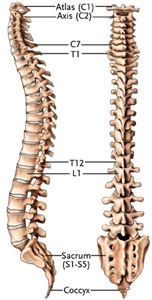What is a disc?
The spine is made up of a number of vertebrae, including 7 cervical vertebrae, 12 thoracic vertebrae, 5 lumbar vertebrae, and the sacrum. Most of the weight of the body and its pressure is on the lumbar vertebrae. The disc is located in the space between two vertebrae. And it is in the form of a small cushion made of cartilage and includes a core in the middle and a solid wall around it. Disc herniation occurs when the surrounding core is torn and the core of the disc moves outwards from its original location, i.e. between the vertebrae, causing daily pressure on nearby structures, especially nerves.
Most hernias occur in the region of the 4th and 5th lumbar vertebrae.
Symptoms: pain in the lower back area with muscle cramps from the back to the legs, symptoms related to sciatic nerve pressure such as numbness, falling asleep, burning sensation and pain in the buttocks and legs, and in cases of progressive weakness and inability to move in the legs or arms.
The pain worsens in the following cases: at night, after standing or sitting for a long time with coughing and sneezing and hitting the body, after getting injured or walking for a long time.
Diagnosis: based on symptoms, MRI photos, CT scan and myelography
Treatment: The aim of the treatment is to relieve the pain and prevent the progress of the disease and reduce the pressure on the nerve and return or increase the person’s ability to perform daily activities.
Necessary cases of lumbar surgery or laminectomy:
Inability to perform daily activities, weakness in legs or hands, disorder in controlling urination or feces
What is laminectomy?
A small blade is removed from the bone of the vertebral column called the lamina and a part of the disc that puts pressure on the nerves.
Pre-operative care: Quit smoking two weeks before the operation. A light meal like soup or salad should be eaten the night before the operation, and no food should be eaten after midnight. The operation area should be free of hair and clean.
Post-operative care:
After the operation, lie on your back and place a pillow under your head and a pillow under your knees to reduce the pressure on the knees.
You can turn on your side. Note that turning on the sides does not cause damage to the back. To turn sideways, first a pillow is placed between your knees. Then the whole body including the head, shoulders, legs and pelvis must be rotated together (like a tree trunk). You must be careful not to rotate the waist area alone. When you are lying on your side, you should not lower your knees too much. You can get out of bed the day after the operation. To get down from the bed, you should lie on one side and then sit down and hang your legs from the bed. Use the farangi toilet. After the operation, there may be a feeling of drowsiness and numbness in the organs, and a narrow tube is placed in the operation site, which is connected to a small container. This tube facilitates the discharge of secretions from the operation site and is removed one to two days after the operation.
Recommendations after discharge:
It takes 6 weeks for the operation site to recover completely, so do not do heavy activity and gradually increase your activity. If the doctor decides, you need physiotherapy or waist corset after the operation.
Avoid sitting or standing for a long time for the first 2 to 4 weeks. Sleep on a firm mattress and keep your back straight while sitting and maintain your weight at the desired level.
Avoid lifting heavy objects. If possible, use the farangi toilet. You can take a shower 3 days after surgery. 14 days after surgery is the time to remove the stitches. The best exercise for you is walking and swimming. Avoid lying on your stomach.
Producer: Roya Rostami Moghadam
Source: Brunner and Sodarth orthopedic book
Compilation date: Summer 1400 Revision date: 3 years later “Mir Hosseini Shiraz Hospital”
Drmirhosseinihospital.com: website
Shirazmirhosseinihospital: Insta
Infomirhosseini@gmail.com: email
Phone: 071-32284433: Fax: 071-32287481

